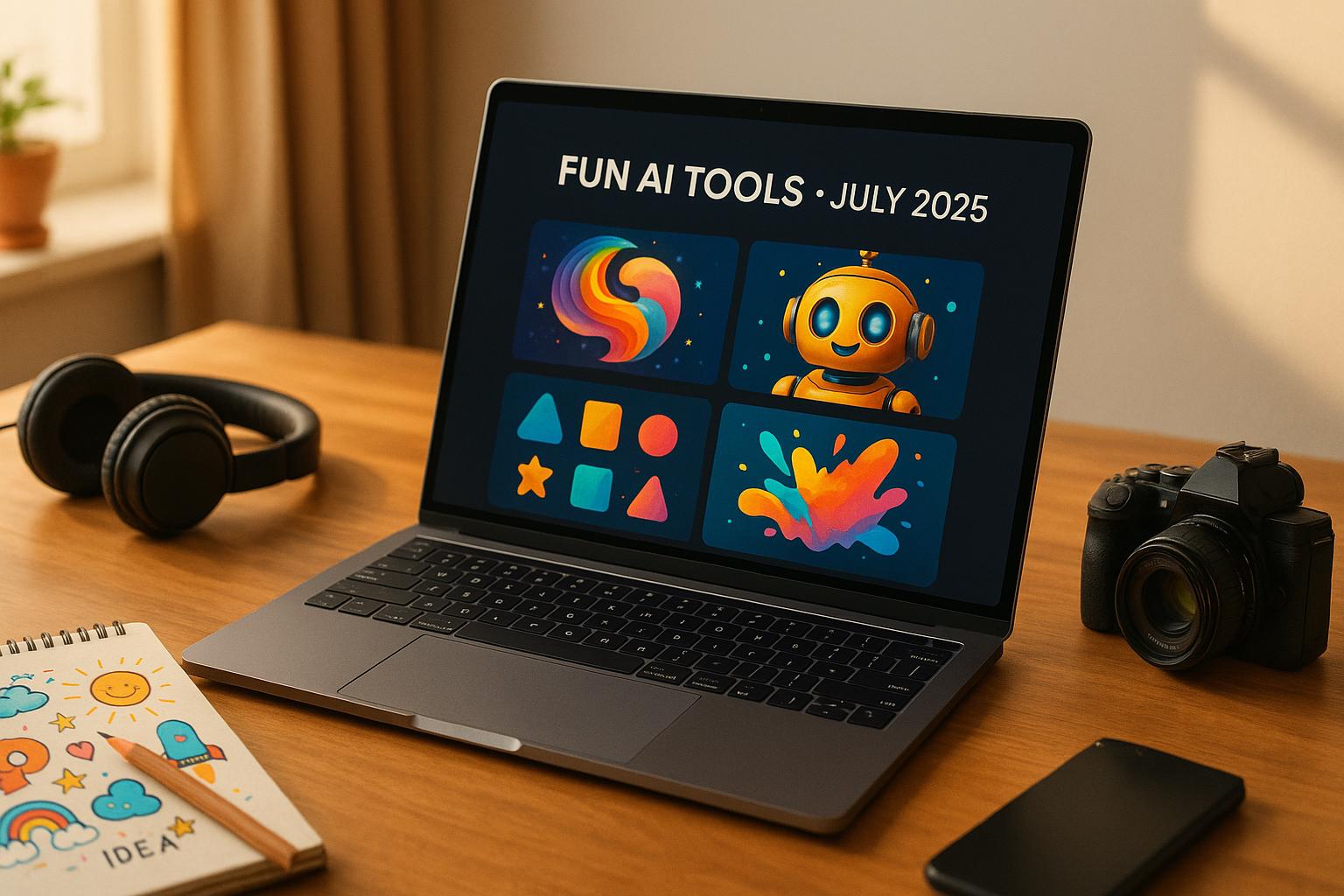AI is transforming textile design, enabling faster, more efficient pattern creation, trend analysis, and customization. Here’s a quick look at seven tools reshaping the industry:
- Patterned AI: Simple, credit-based platform for beginners; great for generating patterns quickly.
- DALL-E 3: Text-to-image AI for creating high-quality, repeating patterns with detailed customization.
- Artbreeder: Unique "genetic blending" system for evolving and merging design elements.
- Designovel: Combines automated design with global trend analysis for professional teams.
- Refabric: Tailors AI to your brand’s identity, offering custom patterns and advanced editing tools.
- StyleAI: Focused on collaboration and maintaining brand design consistency.
- TeeAI: Limited information available, but updates are expected.
Each tool offers something different, whether you're a solo designer or part of a larger team. Below is a quick comparison to help you decide.
Quick Comparison
| Tool | Pricing Model | Best For | Key Feature | Limitation |
|---|---|---|---|---|
| Patterned AI | Free & subscription | Beginners, small projects | Simple pattern generation | Limited advanced features |
| DALL-E 3 | Credit-based | Creative experimentation | High-quality image generation | Costs increase with frequent use |
| Artbreeder | Freemium with upgrades | Experimentation | "Genetic blending" of designs | Steep learning curve |
| Designovel | Custom SaaS contracts | Professional teams | Trend-driven pattern creation | Expensive for individuals |
| Refabric | Tiered pricing | Brand-specific design | Custom AI model training | Focused on fabric-specific needs |
| StyleAI | Subscription-based | Teams, brand collections | Collaboration tools | Limited for single patterns |
| TeeAI | Unknown | TBD | TBD | Insufficient information |
AI tools are simplifying textile design, offering faster workflows and new possibilities. Whether you're creating seasonal collections or exploring new ideas, these tools can help streamline your process.
How to Create your Textile Design with AI - The New Black - AI Textile Design Generator
1. Patterned AI
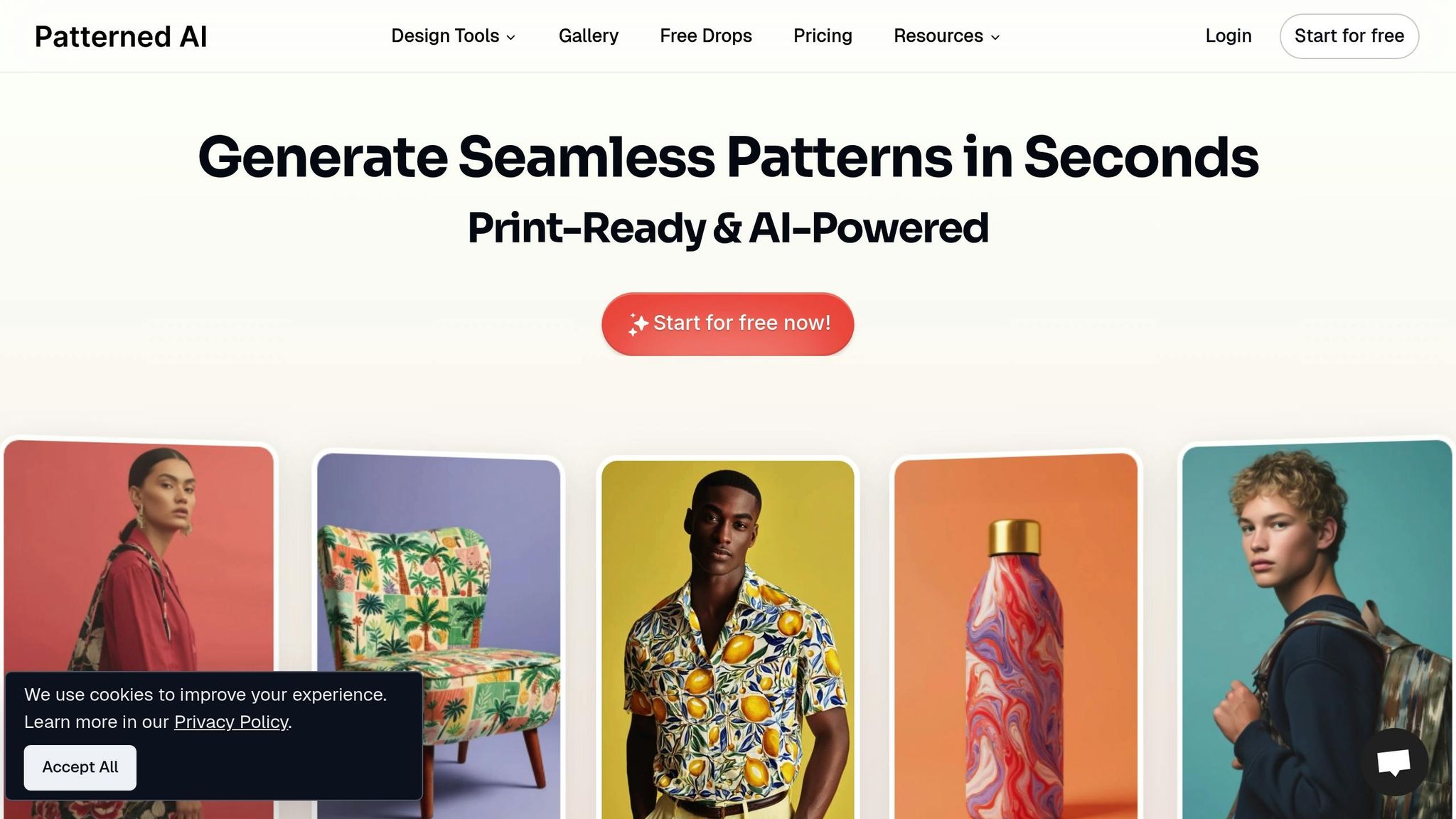
Patterned AI is designed to assist textile designers, whether they’re independent creators or part of larger organizations. Here’s a closer look at its pricing structure and accessibility options.
Pricing and Accessibility
New users can try Patterned AI with a free trial that includes 20 credits, giving them a chance to test out its features. Each image generated starts at 1 credit, though the exact credit cost depends on the features used. The platform offers several subscription tiers: Starter, Standard, and Pro, along with an Enterprise plan for customized solutions. Patterns created under the Starter and Standard plans are public, but Pro and Enterprise subscribers gain the advantage of private pattern ownership.
The platform operates through a web-based interface, meaning no specialized hardware is needed to get started.
2. DALL-E 3
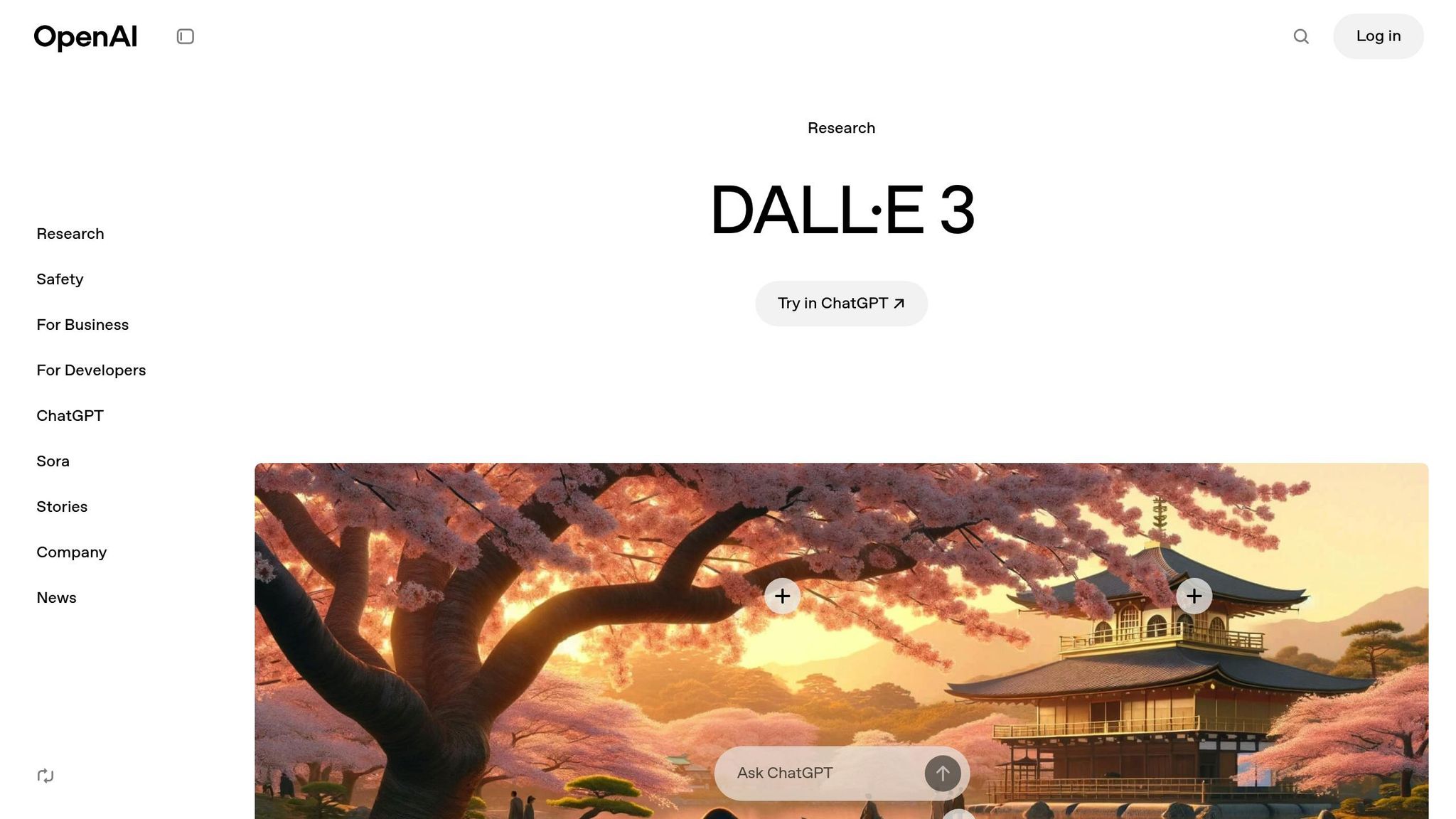
DALL-E 3 takes OpenAI's image generation technology into the world of textile design, offering designers a tool to create distinctive patterns and fabric concepts using simple, natural language. This AI-powered platform opens up new opportunities for designers to experiment with their ideas and push creative boundaries.
Pattern Generation Capabilities
One of DALL-E 3's standout features is its ability to create seamless repeating patterns. Whether it’s intricate florals, geometric shapes, or abstract designs, users can bring their visions to life just by describing them. For example, you could ask for "Art Deco-inspired chevron patterns with metallic gold accents" or "watercolor botanical prints featuring overlapping eucalyptus leaves", and the AI delivers designs tailored to those requests.
It doesn’t stop at just generating patterns. DALL-E 3 blends artistic styles with techniques that mimic traditional methods like batik, tie-dye, or block printing - all with the precision of digital tools. It also handles color palettes with ease, producing designs that maintain harmony across various fabric types.
Customization and Design Flexibility
DALL-E 3 offers step-by-step customization through its prompt refinement system, allowing designers to tweak and perfect their concepts. You can start with a general idea and refine details like color intensity, pattern density, or motif size with follow-up prompts. This means you can make adjustments without starting over from scratch.
What’s more, a single pattern can transform into completely different styles - like moving from a minimalist Scandinavian look to a bold, vintage-inspired design - just by modifying the descriptive language. This adaptability is especially useful during the concept phase when designers need to present multiple options to clients. The platform's design flexibility is also paired with a straightforward pricing structure, making it easy to use for a variety of projects.
Pricing and Accessibility
DALL-E 3 uses a credit-based system on OpenAI's platform, where each image generation consumes a set number of credits. It’s accessible through ChatGPT Plus or OpenAI’s API, making it suitable for individual designers working on smaller projects as well as larger teams handling high-volume work.
The tool is entirely web-based, so there’s no need for specialized hardware or software. As long as you have an internet connection, you can create patterns from any device. Plus, the high-resolution images it generates are ready for both digital mockups and print production, streamlining the design workflow.
3. Artbreeder
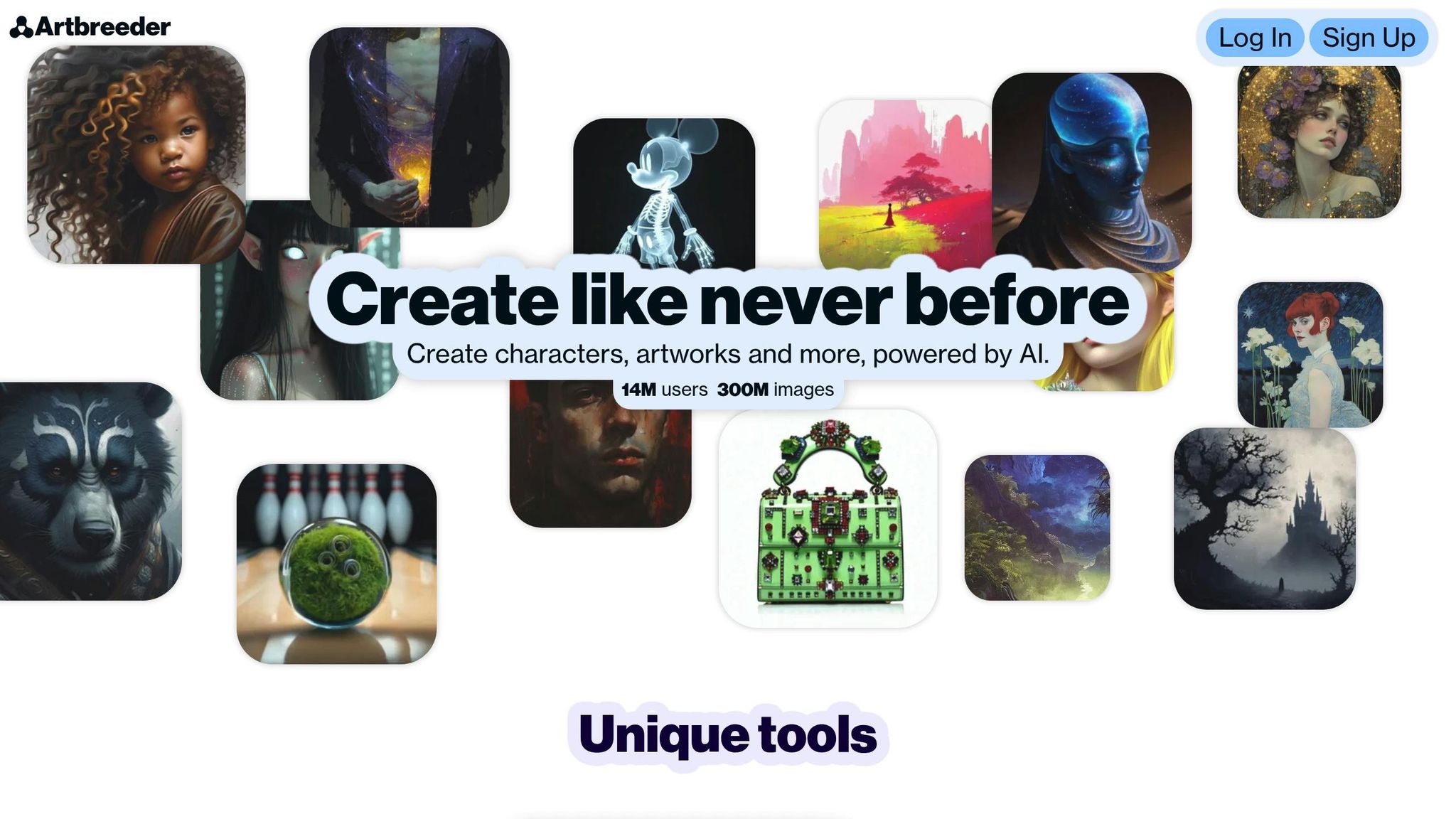
Artbreeder is shaking things up in textile design with its genetic blending techniques. This platform offers a creative way to merge and evolve patterns using a genetic algorithm system. Think of each design as having its own "DNA", which can be combined with others to generate entirely new variations. It’s a fantastic tool for experimenting with fresh ideas and pushing creative boundaries. The result? Patterns that feel both familiar and completely new, perfect for designers looking to expand their creative horizons.
Pattern Generation Capabilities
Artbreeder’s genetic mixing system makes it easy to blend different design elements into hybrid patterns. For example, you can combine floral motifs with geometric shapes to create structured botanical designs that beautifully balance both styles. The platform thrives on creating organic variations, where subtle changes are introduced naturally through the blending process.
It’s also a game-changer for texture development. Designers can start with simple fabric textures, like linen or silk, and evolve them into more intricate surfaces by blending them with other material patterns. Whether you’re designing a single piece or an entire collection, the tool’s ability to generate endless pattern variations from one starting design is invaluable. You can tweak attributes like pattern density, color saturation, or motif complexity while keeping the original design DNA intact. This makes it easy to create cohesive pattern families or seasonal collections with a unified look.
Customization and Design Flexibility
Artbreeder offers intuitive controls that let you fine-tune every detail of your design. Using simple sliders, you can adjust color intensity, pattern scale, and even the prominence of specific design elements - all without losing the overall harmony of the pattern.
The platform also tracks your version history, so you can explore multiple design directions from a single starting point. This feature is especially handy for comparing variations or revisiting earlier iterations. Whether you’re experimenting with different styles or refining a single concept, Artbreeder ensures you never lose your progress.
Collaboration is another standout feature. Designers can share genetic material with team members, enabling true teamwork on pattern development. This is especially useful for studios working on large collections, where maintaining consistency across multiple designs is key.
Pricing and Accessibility
Artbreeder uses a freemium model, making it accessible to everyone. The free tier includes essential pattern generation tools and allows users to create and download standard-resolution designs - perfect for early-stage concepts or client presentations.
For more advanced features, premium plans start at $8.99 per month, offering higher resolution downloads, faster processing, and access to enhanced algorithms. The professional plan, priced at $18.99 per month, adds commercial licensing rights and priority processing, making it ideal for businesses.
You don’t need any special software or hardware to use Artbreeder. It runs entirely in your web browser, so as long as you have an internet connection, you’re good to go. Patterns are downloaded in standard image formats, which integrate smoothly into existing textile design workflows and CAD systems.
4. Designovel
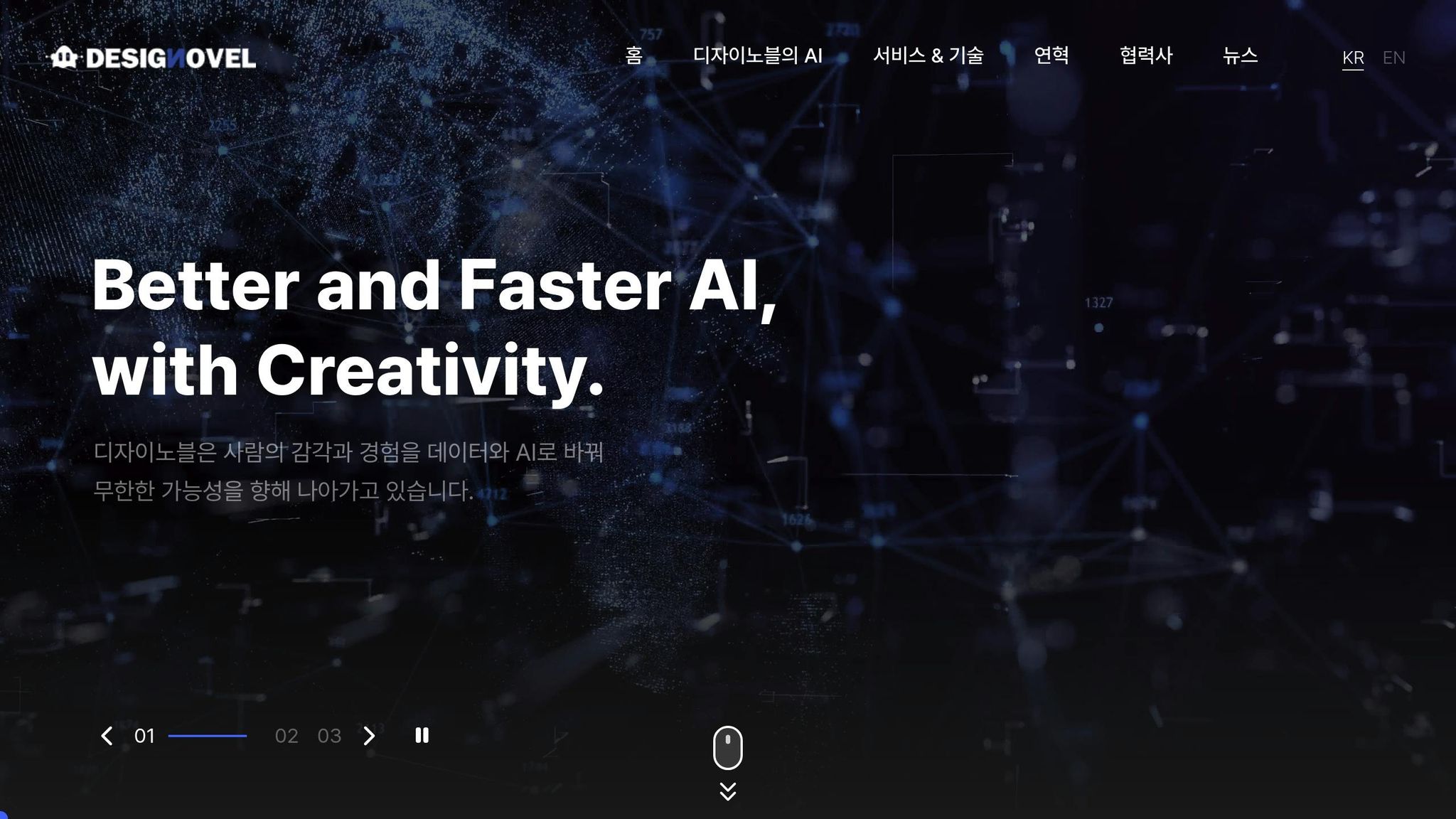
Designovel combines design automation with market insights, using advanced methods like Metri Learning and multi-modal embedding to craft designs that align with market trends. By merging automated pattern creation with detailed market analysis, it offers a powerful tool for modern textile design. The platform pulls global fashion data from e-commerce sites, social media, and runway shows to guide its design recommendations.
Pattern Generation Capabilities
Designovel uses conditional generation to merge visual and textual inputs, creating highly targeted patterns. Its Contents Generative AI analyzes user needs and generates designs accordingly. In 2021, testing conducted by the Korean Testing Laboratory (KTL) confirmed the platform's accuracy in design quality and similarity.
Collaborations with well-known brands have further validated the effectiveness of Designovel's approach.
Market Trend Analysis Features
In addition to designing patterns, Designovel continuously tracks global fashion trends to refine its creative outputs. It provides a SaaS dashboard that delivers actionable insights, such as trending colors, popular patterns, and emerging style directions. For designers working on seasonal collections, these insights can guide new design ideas, ensuring patterns resonate with current market demands.
Customization and Design Flexibility
With these insights, designers can create designs that align with evolving trends. Designovel allows users to upload mood boards and text to generate custom patterns, blending traditional styles with contemporary aesthetics.
The platform's ability to analyze global data also enables it to suggest design variations tailored to specific markets or demographics, helping designers craft collections that appeal to different regions or customer groups.
Pricing and Accessibility
Designovel operates on an enterprise pricing model, offering custom SaaS contracts. It also provides ARaaS (Analysis & Reporting as a Service) and occasional free trend reports for smaller brands. The platform is accessible to a range of organizations, including small businesses, startups, and nonprofits, with pricing adjusted to fit individual needs and usage levels.
sbb-itb-212c9ea
5. Refabric
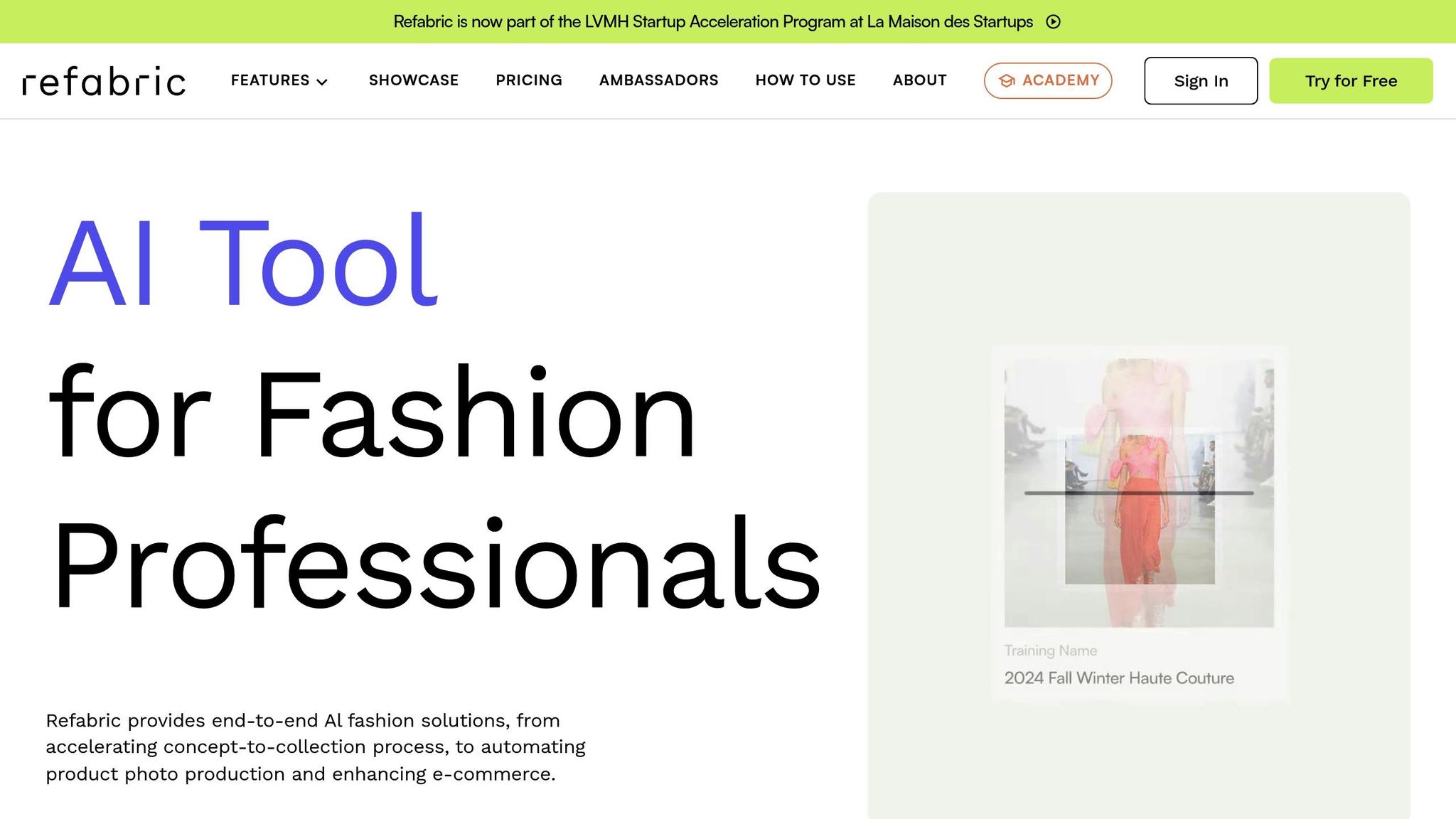
Refabric takes a unique approach by offering AI training tailored to your brand's identity. By analyzing your branded imagery and seasonal mood data, the platform creates custom AI models that align with your specific aesthetic. This ensures that the generated patterns not only reflect your brand's style but also open up new creative avenues.
Pattern Generation Capabilities
Refabric specializes in creating custom textile patterns based on inputs like mood, season, cultural influences, color palettes, textures, and themes. Its algorithms suggest compositions, color schemes, and fabric simulations that match your brand's vision. A standout feature is its ability to digitize cultural motifs, which allows designers to reinterpret and regenerate traditional patterns into multiple variations while respecting their cultural roots. This makes it easier to integrate heritage-inspired designs into modern collections.
These custom-made patterns provide a foundation for flexible designs that can be personalized to meet customer preferences.
Customization and Design Flexibility
Refabric doesn't stop at generating patterns - it also provides powerful editing tools. Designers can refine specific sections of a pattern by selecting areas and using text or visual input to guide adjustments. With these tools, creating seasonal collections that reflect a brand's distinct vision becomes more streamlined. The platform also supports mass customization, enabling brands to adapt traditional patterns to suit individual tastes. Customers can modify designs, select custom color schemes, or even collaborate on textile creations within guided frameworks. Real-time digital garment previews enhance the shopping experience by boosting engagement and confidence.
The platform goes further by optimizing patterns for different fabric types, ensuring that designs maintain their vibrancy and alignment across various materials. For instance, a designer could use Refabric to merge floral motifs with abstract geometric shapes, achieving a surreal aesthetic that would be difficult to craft manually.
Pricing and Accessibility
Refabric is ideal for creating limited-edition prints and highly personalized designs for niche markets. Boutique brands, for example, can develop exclusive prints that reflect local cultural and seasonal trends, fostering deeper connections with their audience. The platform also analyzes customer preferences, market trends, and feedback to produce designs that resonate strongly with target demographics.
6. StyleAI
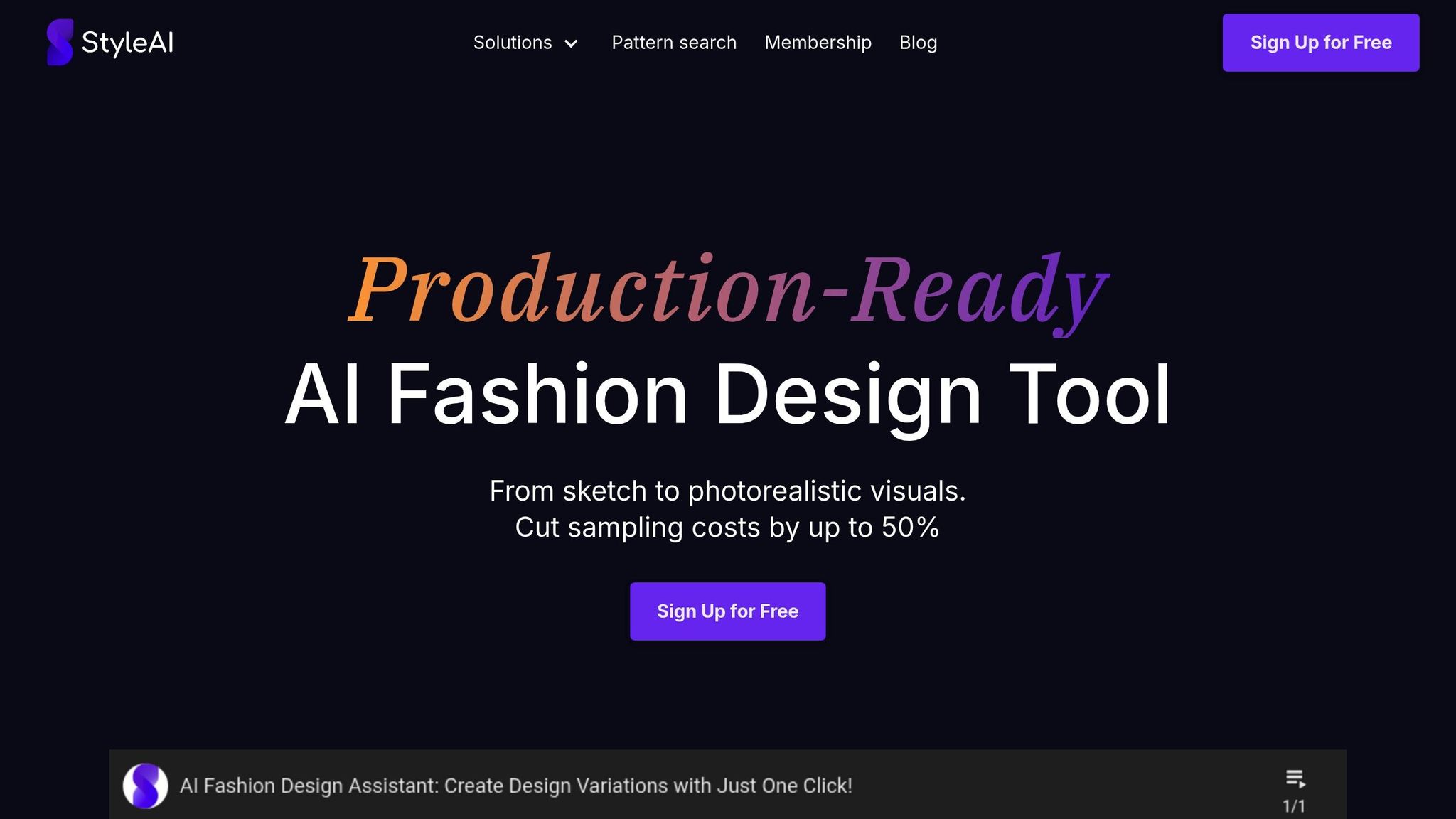
StyleAI is a platform powered by artificial intelligence, designed to cater to teams looking for a collaborative and personalized approach to textile design. Whether you're an independent designer or part of a larger organization managing multiple collections, StyleAI adapts to fit your needs.
Customization and Collaboration
The platform shines in its ability to support teamwork and maintain brand consistency. It uses shared design histories and advanced brand training to ensure that every project aligns with a brand's unique style. Team members can collaborate effortlessly on textile designs, while the AI learns and adapts to specific design preferences. For agencies or businesses juggling multiple brands, the feature of supporting multiple brand workspaces is a game-changer.
Pricing and Accessibility
StyleAI combines its robust features with flexible pricing options. If you're just starting out, you can explore the platform's basic features for free. Solo designers can access essential tools through the Designer Plan for $19.99 per month. For teams and established brands, the Brand Plan is available at $49.99 per seat per month, offering advanced collaboration tools and brand training features, along with a 5-day free trial. Larger organizations handling several brands can opt for the Enterprise Plan, which offers custom pricing, unlimited brand workspaces, tailored onboarding, and priority support.
7. TeeAI
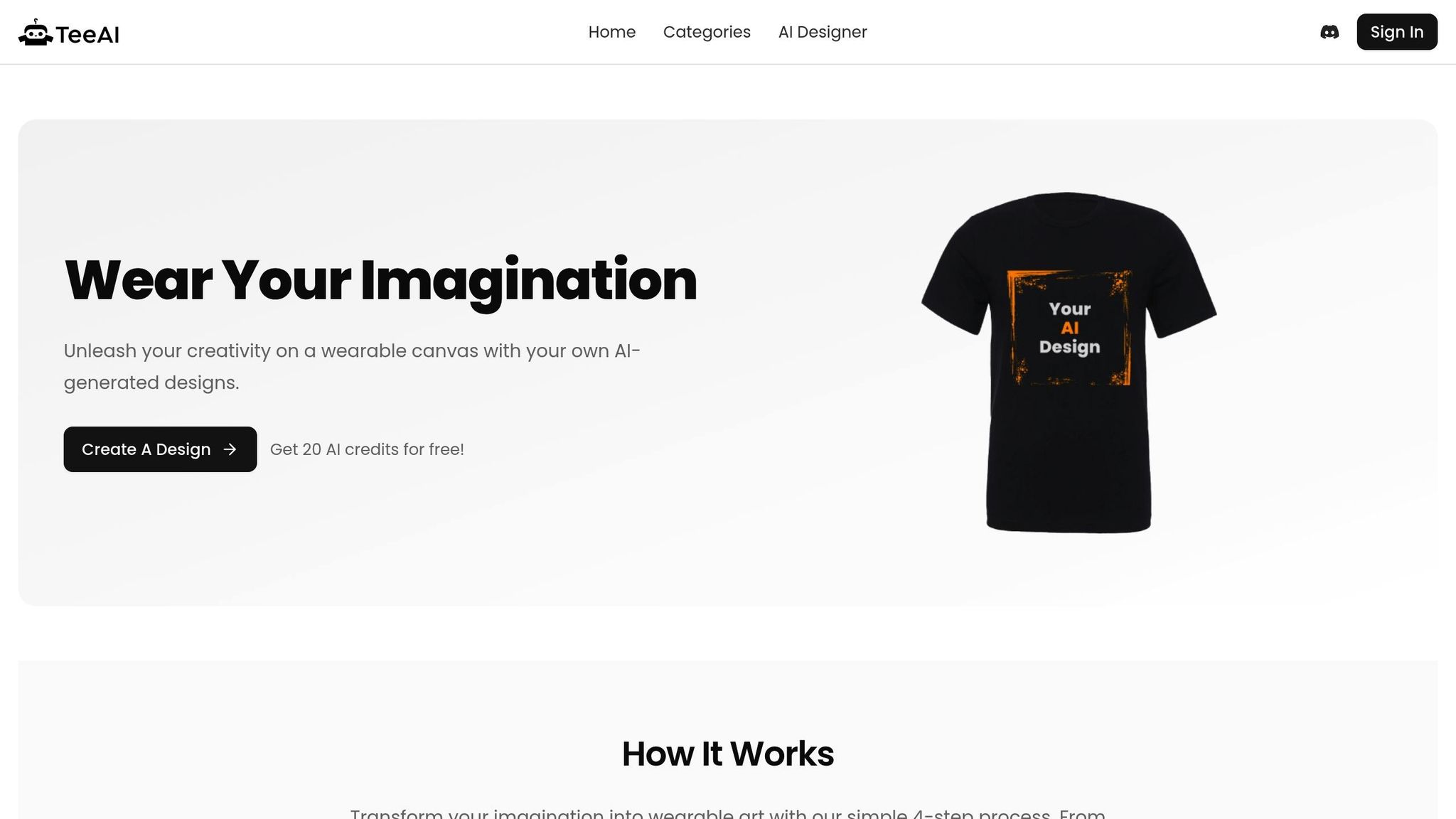
At this time, information about TeeAI's textile design features, customization options, and pricing is unavailable. Updates will be provided as soon as more details are confirmed.
Tool Comparison Chart
After diving into the features of each tool, here's a side-by-side comparison to help you make an informed decision.
Whether you're an independent designer, part of a small studio, or working with a professional fashion team, there's a tool to match your creative vision and budget. Each tool offers something different, from pricing models to unique strengths, so understanding these distinctions can help you pick the right fit.
Here's a quick overview of the key aspects:
| Tool | Pricing Model | Best For | Key Strength | Main Limitation |
|---|---|---|---|---|
| Patterned AI | Free tier & subscription | Beginners and small projects | Easy-to-use pattern generation | Fewer advanced features compared to premium tools |
| DALL-E 3 | Credit-based | Creative exploration | High-quality, flexible image generation | Costs can add up with frequent use |
| Artbreeder | Freemium with premium upgrades | Experimenting with design variations | Unique blending of visual elements | Takes time to master for best results |
| Designovel | Subscription-based | Professional fashion teams | Combines trend analysis with pattern creation | May be pricey for individual designers |
| Refabric | Tiered pricing | Technical textile applications | Focused on fabric-specific design capabilities | Narrow focus may not suit broader creative needs |
| StyleAI | Subscription-based | Creating cohesive style collections | Advanced customization with commercial licensing | Less detailed for single pattern creation |
| TeeAI | Pricing information not available | – | – | Limited publicly available information |
If you're just starting out or managing a smaller budget, free or low-cost tools like Patterned AI or Artbreeder can be great for testing workflows and exploring possibilities. On the other hand, larger teams or established fashion houses might find the advanced features of subscription-based tools like Designovel or StyleAI worth the investment. Always check the latest details on each tool's website to ensure it aligns with your needs.
Conclusion
AI tools are transforming textile design by replacing traditional hand-drawn methods with the ability to generate diverse patterns instantly. For designers aiming to stay competitive, integrating these tools isn't just an option - it’s becoming a necessity. Whether you're an independent creator crafting a small collection or part of a major fashion house preparing a seasonal line, AI-powered tools are quickly becoming essential in today’s fast-moving industry.
These tools make it easier to modify existing patterns, combine different styles, or generate entirely new motifs with just a few prompts. This efficiency not only speeds up the creative process but also reduces production costs during the design phase. Instead of starting designs from scratch, textile designers can now iterate and customize with greater ease and speed.
Platforms like DALL-E 3 and Artbreeder take things a step further by enabling seamless blending of artistic styles and the creation of intricate repeating patterns. These capabilities open up creative possibilities that were once out of reach, giving designers more freedom to experiment and innovate.
For those diving into AI-driven textile design, AI Apps offers a curated library of over 1,000 tools. With advanced filtering options, designers can quickly find the tools that suit their specific needs and budgets, saving valuable time and effort in the research process.
FAQs
How can AI tools like DALL-E 3 and Artbreeder boost creativity in textile design?
AI tools like DALL-E 3 and Artbreeder are transforming the way textile designers work, offering the ability to create distinct patterns and visuals in no time. By using text prompts or existing images, these tools help designers craft personalized and unique designs while saving a significant amount of time in the development process.
They also open the door to endless experimentation. Designers can easily test out a variety of ideas, refine their concepts, and adjust designs without breaking a sweat. Whether you're working on bold, eye-catching patterns or delicate, understated textures, these tools make the creative process quicker, more adaptable, and full of possibilities.
What should I look for when choosing an AI tool for textile design?
When choosing an AI tool for textile design, look for features that enhance your creative workflow. Key functionalities to consider include pattern generation, color matching, and fabric texture simulation. These tools not only streamline the design process but also make it easier to bring your ideas to life.
It's also important to ensure the tool works well with your existing design software and fits smoothly into your workflow. Seamless integration helps maintain efficiency and prevents unnecessary interruptions. Some tools even offer advanced features like pattern optimization, which can help reduce material waste or improve garment fit - great for achieving more sustainable and cost-conscious designs.
Lastly, don't overlook factors like ease of use, pricing, and the ability to scale. These elements will determine whether the tool meets your current needs while also supporting your future growth.
Can AI tools help create textile designs that reflect specific brand styles or cultural traditions?
AI tools in textile design offer the flexibility to mirror a brand's distinct style and integrate traditional influences. By analyzing uploaded assets such as logos or previous designs, these tools can create patterns that stay true to a brand's identity. They can also examine traditional patterns and motifs, crafting designs that respectfully incorporate elements of cultural heritage.
With their ability to blend advanced pattern recognition with customization options, these tools make it possible to produce designs that feel personal and purposeful, meeting a wide range of creative demands.

